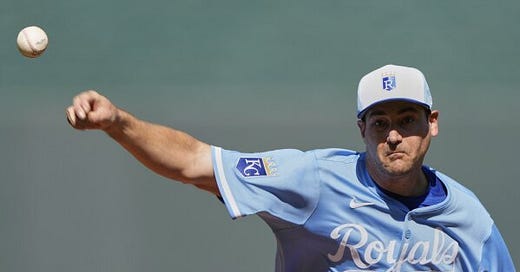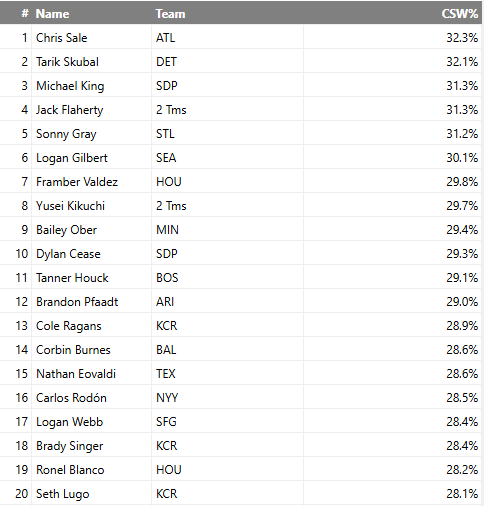Saturday Study Hall, Vol. 2
Tying whiffs with called strikes to grade pitchers and pitch types using CSW%
Saturday Study Hall is a biweekly series diving into advanced stats, data and analytics to investigate how they impact the Royals.
Whiffs are flashy. They send fans to their feet at the end of a stressful inning. They appear in highlight reels. They’re featured on Pitching Ninja’s daily threads.
Rifling a pitch through a hitter’s swing in a big spot brings out the emotions and often shifts momentum of an at-bat, if not the game itself. Whiffs, and whiff rate, tell us about a pitcher’s nastiness.
Equally effective, if not as evocative: called strikes.
Dotting a fastball on the inner edge, perfectly placing a changeup on the outer corner or slipping a curveball in the back door, like Lugo does above to a hapless Nicky Lopez, may not evoke the same visceral response that comes after a hitter waves helplessly at a pitch, but called strikes are just as impactful for a pitcher’s success.
Those two pitch results — called strikes and whiffs — are the only outcomes guaranteed to produce a positive result for a pitcher. There’s no ball in play to reach the grass or seats. No contact that could sneak through the infield or ricochet off a glove.
Just a strike.
If it sounds simple, it’s because it is — and combining called strikes and whiffs gives us a statistic that points to a pitcher’s ability to avoid contact while generating strikes. The foundation of pitching.
Called strike plus whiff rate. Or CSW% for short.
In equation form: Called Strikes + Whiffs / Total Pitches
As you can see from Kris Bubic’s dominant first start of 2025 against the Milwaukee Brewers via Baseball Savant, he generated a particularly solid CSW% thanks primarily to his high-ride four-seam fastball, which earned both 11 whiffs and 11 called strikes among 48 total offerings.
You can read more about the predictive nature of CSW% on Pitcher List, where the statistic was created, but it does harness some predictive power by showing us which pitchers are most often avoiding contact while working in the strike zone.
A solid CSW% lands around 27%, with the best arms in the game surpassing 30% over the course of a season. Just look at last year’s leaderboard among qualified pitchers — it’s largely a who’s who of All-Stars and aces (along with the usual outliers, like any statistic).
No single metric is perfect, of course, but you should require no further proof that CSW% matters than seeing last year’s Cy Young winners finishing first and second on the leaderboard.
For all its strengths, and it truly is a stat I love to use, there is one major wart. The weakness of CSW% is it tells us zilch about contact. (Which is sort of the point of the statistic, to be fair.)
Pitchers who consistently throw strikes and are able to generate whiffs but allow damage on contact might hold up well to the CSW% test while turning in subpar performances. Yusei Kikuchi from our above leaderboard is a perfect example — while Kikuchi is a fine pitcher (and earned some down ballot Cy votes last year), finishing eighth in CSW% might lead you to believe he held an upper-echelon ERA. But no — because he allowed the ninth-highest average exit velocity and fourth-highest hard-hit and barrel rates among qualifying pitchers, his ERA ballooned to 4.05. Still a number you can live with, sure, but not exactly elite as the CSW% might indicate.
CSW% also tends to view relievers more favorably as they’re naturally more inclined to let their “stuff” play up in the zone in shorter stints, which is something to keep in mind as you’re comparing, say, Michael Wacha to James McArthur, if you were ever inclined to do something so odd.
KC’s 2024 CSW% Leaders
Ace Cole Ragans and American League Cy Young runner-up Seth Lugo finished with top 20 CSW rates leaguewide in 2024. How do the rest of the Royals fare?
At some point we’ll be ready to turn our focus to 2025 statistics, but we’re early enough in the campaign still that it makes sense to pull full-season numbers from last year.
*Note, these lists don’t include pitchers no longer with the Royals (Brady Singer, Nick Anderson, Will Smith, Carlos Hernandez). I’ve added Carlos Estevez’s 2024 rate from his time with the Angels and Phillies, and Lucas Erceg’s, Hunter Harvey’s and Michael Lorenzen’s rates are from the full season, not just their time with the Royals after they came over via trades.
(Data courtesy of FanGraphs, minimum 30 innings pitched.)
Starting Pitchers
Cole Ragans, 28.9%
Seth Lugo, 28.1%
Alec Marsh, 26.8%
Michael Wacha, 26.2%
Michael Lorenzen, 25.7%
Relief Pitchers
Kris Bubic, 34%
James McArthur, 31.4% (another prime example of CSW% not telling you McArthur allowed quite a bit of loud contact in 2024)
Lucas Erceg, 31.3%
Daniel Lynch, 30.9%
Carlos Estevez, 28.6%
Hunter Harvey, 28.1%
Sam Long, 28%
Angel Zerpa, 26.1%
Chris Stratton, 25.4%
John Schreiber, 25.1%
KC’s 2024 CSW% Leaders by Pitch Type
CSW% can be applied to individual pitches, too, giving us a peek at which weapons a pitcher can rely on for strikes and whiffs.
(Data courtesy of TJ Stats, minimum 100 pitches.)
Starting Pitchers
Seth Lugo, Curveball, 36%
Cole Ragans, Knuckle Curve, 35.9%
Alec Marsh, Sweeper, 35.8%
Cole Ragans, Changeup, 35%
Michael Lorenzen, Curveball, 33.5%
Seth Lugo, Four-Seam Fastball, 32.2%
Michael Wacha, Changeup, 31.6%
Alec Marsh, Slider, 31.1%
Alec Marsh, Curveball, 31%
Michael Wacha, Four-Seam Fastball, 29.6%
Relief Pitchers
Kris Bubic, Four-Seam Fastball, 40.6%
James McArthur, Slider, 39.2%
Daniel Lynch, Slider, 35.3%
Carlos Estevez, Slider, 35.1%
Lucas Erceg, Four-Seam Fastball, 34.1%
Lucas Erceg, Slider, 34.1%
Sam Long, Slider, 33.3%
Daniel Lynch, Changeup, 32.6%
John Schreiber, Four-Seam Fastball, 32%
Chris Stratton, Four-Seam Fastball, 31.5%
Have a suggestion for a future Saturday Study Hall? Let me know in the comments.








I am by no means anti-advanced stats, but I also wouldn't label myself as an analytics guy either. I like to think I'm a mix of old and new school, even if I tend to lean traditional, but I thought this was an excellent intro to a stat I've never followed too closely. A few more articles like this and you just might turn me into a real sabremetrician.
Love this article. Never explored this stat at all before. This may be my new favorite evaluation tool. Add this and average exit velocity against and I would bet the top of the list of those numbers put together is a who's who of elite pitchers.